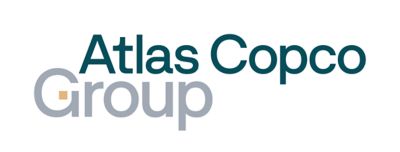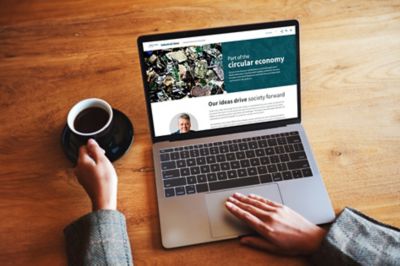ATLAS COPCO Preliminary 12-months and interim report at December 31, 2000 (unaudited)
February 12, 2001
Continued strength in the fourth quarter
Dividend The Board of Directors proposes that a dividend of SEK 5.25 (4.75) per share be paid for the 2000 fiscal year. Near-term outlook In North America, the recent downturn in demand, mainly for electric tools and other construction-related equipment, is expected to continue. However, demand for equipment rental is expected to continue to improve, driven by the outsourcing trend. The outlook for demand in Europe is relatively stable. A high level of capacity utilization in many industries is expected to stimulate demand for investment-related equipment. In Asia, the high level of demand is expected to continue. In summary, overall demand for Atlas Copco's products and services is expected to remain at current levels. Summary of full-year results Atlas Copco Group For the year 2000, the Atlas Copco Group's orders received were up 28 percent, to SEK 46,628 m. (36,534), corresponding to a volume increase of 11 percent for comparable units. Foreign exchange rate fluctuations had a positive translation effect of approximately 6 percentage points. Revenues were SEK 46,527 m. (36,234), also up 28 percent, corresponding to a volume increase of 12 percent. The Group's operating profit increased 43 percent, to SEK 6,392 m. (4,470), corresponding to a margin of 13.7 percent (12.3). The operating profit includes net non-recurring items equal to SEK -26 m. (+83). The main nonrecurring items were a net gain of SEK 134 m. from the SPP pension refund and related pre-retirement provisions, and a restructuring charge of SEK 127 m. in the Rental Service business area. Profit after financial items amounted to SEK 4,689 m. (3,412), corresponding to an increase of 37 percent and a margin of 10.1 percent (9.4). Operating cash flow before acquisitions and dividends equaled SEK 1,276 m. (2,413). The negative change resulted from investments made by the Rental Service business area in its rental fleet and an increase in the Group's working capital. Review of fourth-quarter business Atlas Copco Group Market development The market for Atlas Copco's products and services in North America continued to show strong demand overall. Activity in the construction industry stayed high, benefiting rental equipment, while purchase of construction-related products was somewhat lower. The industrial sector remained buoyant. Demand for large investment equipment was also favorable, although a slight slowdown was noted during the quarter. In Europe, the overall level of demand improved slightly, but imbalance remains in the region. Sales in southern Europe continued to record steady growth, while the Nordic countries were relatively weak. The level of activity in Germany was relatively high but little new investment was made. The positive trend in Asia continued, with strong expansion in China and Southeast Asia. Demand from the mining industry, particularly for after-market products, continued at a good level in most mining related economies. Orders and revenues Orders received totaled SEK 12,177 m. (10,210), up 19 percent from the fourth quarter of 1999. The increase corresponds to a volume gain of 7 percent, excluding a positive translation effect of 10 percentage points and a net effect from acquisitions and divestments of 1 percent. The volume of orders received expanded thanks to strong demand for Atlas Copco's products and services in most geographic regions, with the exception of the U.S. market, where sales of equipment to the building industry decreased. Revenues increased 22 percent, to SEK 12,841 m. (10,507), corresponding to a volume gain of 11 percent for comparable units. Earnings and returns Operating profit for the fourth quarter increased 30 percent, to a record SEK 1,823 m. (1,400), corresponding to a margin of 14.2 percent (13.3). These figures include SEK 20 m. in restructuring charges for Compressor Technique. The margin improved as a result of higher volumes and the efficiency gains. The more favorable foreign exchange environment had no effect on the operating margin compared to last year but did add about SEK 100 m. to operating profit. Seasonally low demand for rental equipment in the United States, paired with higher costs related to a larger rental fleet than a year ago, had a negative effect on the Group's operating margin. Net financial items amounted to SEK -452 m. (-378), of which net interest items accounted for SEK -434 m. (-363) and foreign exchange differences for SEK -18 m. (-17). Interest expense was higher than 1999, chiefly the result of a substantially higher USD/SEK exchange rate. Profit after financial items rose 34 percent, to SEK 1,371 m. (1,022), corresponding to a margin of 10.7 percent (9.7). Net profit for the quarter totaled SEK 864 m. (677), or SEK 4.12 per share (3.27). In 2000, the return on capital employed was 15 percent (14), and the return on shareholders' equity 13 percent (14). The Group's weighted average cost of capital (WACC) was approximately 8 percent (8), corresponding to a pretax cost of capital of approximately 12 percent. Cash flow and net indebtedness The operating cash surplus after tax for the fourth quarter reached SEK 1,745 m. (1,663). Cash flows from financial hedging transactions had a net effect of SEK -384 m. (+46). Working capital increased SEK 327 m. (decreased 29) in the quarter, while inventory turnover continued to improve year-on-year, primarily due to improvements in supply-chain management. Total cash flow from operations reached SEK 1,418 m. (1,692), corresponding to 11 percent (16) of Group revenues. Net investment in tangible fixed assets was SEK 603 m. (624) during the quarter. Net cash flow after dividends and acquisitions reached SEK 850 m. (5,123). The figure for the fourth quarter in 1999 included SEK 4,125 m. from an equity issue. The Group's net indebtedness (defined as the difference between interest-bearing liabilities and liquid assets) amounted to SEK 22,270 m. (19,325), of which SEK 1,521 m. (1,450) was attributable to pension provisions. The debt/equity ratio (defined as net indebtedness divided by shareholders' equity) was 92 percent (92). Adjusted for pure translation effects since December 31, 1999, the debt/equity ratio was 84 percent at December 31, 2000. Investments Gross investments in property, machinery, and buildings totaled SEK 279 m. (243). Gross investments in rental equipment amounted to SEK 739 m. (776). Depreciation on these two asset groups equaled SEK 240 m. (245) and SEK 676 m. (506) respectively, while amortization of intangible assets was SEK 180 m. (153). People At December 31, 2000, the number of employees was 26,772 (26,134). For comparable units, the number of employees increased by 382 from December 1999. Share capital Share capital totaled SEK 1,048 m. (1,048) at the end of the period, distributed as follows. Class of share Shares outstanding A shares 139,899,016 B shares 69,703,168 Total 209,602,184 In October 1999, 26.1 million new shares were issued at a subscription price of SEK 160 per share through a 1:7 rights issue. The issue provided the Company with net proceeds of approximately SEK 4.1 billion. Compressor Technique Business Area The Compressor Technique business area consists of five divisions in the following product areas: industrial compressors, portable compressors, generators, and gas and process compressors. Orders received during the fourth quarter were up 18 percent to SEK 3,785 m. (3,207), corresponding to an increase in volume of 14 percent, after adjustments for a positive foreign exchange effect of 6 percentage points and the effects of divested businesses. Continuing the trend from the first nine months of the year, sales volumes continued to grow for all product areas. Slower demand was noted in North America, while favorable sales trends in South America continued. In Europe, sales were unmistakably in an upturn. The strong increase in demand from Asia, especially in China, resulted in many orders for all types of products. Overall, after-market business progressed and kept expanding its share of total revenues. The extended, superior range of small and medium-sized oil-injected screw compressors that was launched in the third quarter was received favorably by the market. Revenues increased 17 percent, to SEK 4,107 m. (3,521), as volumes were 14 percent greater than in the same quarter the preceding year. Operating profit improved 30 percent, to a record SEK 795 m. (612), corresponding to an operating margin of 19.4 percent (17.4). The profit includes a non-recurring cost of SEK 20 m., mainly for restructuring the dryer manufacturing operations. The net effect of higher volumes and somewhat higher operating costs accounted for most of the margin improvement. Construction and Mining Technique Business Area The Construction and Mining Technique business area consists of five divisions in the following product areas: drilling rigs, rock drilling tools, exploration equipment, construction tools, and loading equipment. In the fourth quarter, orders received increased 6 percent to SEK 1,753 m. (1,658). There was a positive translation effect of about 5 percent, and prices increased marginally. Volumes remained high, at the same level as the preceding year. The mining industry continued to invest and several new contracts were signed, especially for consumables. Activity in the construction sector was weaker than in the fourth quarter of 1999, particularly in the United States. A brand transition program is under way in the business area with the objective of using the strong corporate brand, Atlas Copco, for all divisions. Revenues were SEK 1,898 m. (1,572), up 21 percent overall, corresponding to a volume increase of 14 percent. Operating profit for the quarter rose 41 percent, to SEK 171 m. (121), corresponding to a margin of 9.0 percent (7.7). All product areas improved their performance compared with the preceding year. Fluctuations in foreign exchange rates had no material effect on the operating margin. A higher share of big machine sales in the quarter affected the margin somewhat negatively compared to the first three quarters of 2000. Industrial Technique Business Area The Industrial Technique business area consists of four divisions in the following product areas: industrial power tools, professional electric tools, and assembly systems. Order intake increased 10 percent overall compared with the fourth quarter of 1999, to SEK 2,876 m. (2,626), corresponding to a decrease in volume of 2 percent. Prices increased marginally and the positive foreign exchange effect was about 10 percent. Order intake for computer-controlled tightening systems remained strong in the United States and in Europe. Orders for standard products from the general industry were flat overall during the fourth quarter. The demand for professional electrical tools for construction and installation work weakened during the quarter in both North America and Europe. The Atlas Copco Industrial Tools and Equipment division merged its two product companies and created a more customer-focused organization by forming separate business units for the motor vehicle industry, general industry, and service. The division changed its name to Atlas Copco Tools and Assembly Systems. Revenues were SEK 3,161 m. (2,730), up 16 percent from the fourth quarter of 1999. The corresponding increase in volume was 5 percent. Operating profit increased 40 percent to SEK 378 m. (271). The operating profit margin was 12 percent (9.9). The improved margin reflected general operational improvements in the business area and a favorable revenue mix thanks to stronger sales of sophisticated industrial power tools. The net effect of changes in foreign exchange rates was negligible. Rental Service Business Area Since January 1, 2001, the Rental Service business area has consisted of a single division in the equipment rental industry in North America, providing services to construction and industrial markets. Revenues for the fourth quarter increased 37 percent, to SEK 3,849 m. (2,815). The volume gain was 11 percent for comparable units. Translation effects from foreign exchange fluctuations added 18 percent, while acquisitions and price changes had a net effect of 8 percent. On average, rental rates were only marginally less in the preceding year. Rental revenues accounted for 74 percent of total revenues in the quarter. Sales of equipment, parts, and merchandise represented 16 percent of revenues, and sales of used equipment totaled 10 percent. The equipment rental business continues to grow at a faster pace than the industries it serves because of the trend towards renting instead of owning equipment. Business activity in the construction sector, where non-residential building is the biggest customer segment, remained steady despite harsh weather conditions at the end of the quarter. The industrial side of the business continued to strengthen, albeit without the ???Y2K effect??? that boosted last year's fourth quarter. The merger of Prime and RSC was effective January 1, 2001, from which date the entire new division, named Rental Service Corporation, has used the same fleet and IS platform. Operating profit, including goodwill amortization, was SEK 532 m. (422), corresponding to a margin of 13.8 percent (15.0). Seasonally low demand for rental equipment in the United States, paired with higher costs related to a larger rental fleet than a year ago, had a negative effect on the operating margin. Parent Company Profit after financial income and expense for Atlas Copco AB totaled SEK 2,026 m. (1,261). Net profit for the year, after appropriations and taxes, was SEK 1,673m. (1,037). Dividend The Board of Directors proposes that a dividend of SEK 5.25 (4.75) be paid for fiscal 2000. That corresponds to a total of SEK 1,100 m. (996). Stockholm, February 12, 2001 Giulio Mazzalupi President and Chief Executive Officer Financial Targets The overall objective for the Atlas Copco Group is to achieve a return on capital employed that will always exceed the Group's total cost of capital. The targets for the next business cycle are to grow revenue at an annual rate of 8 percent, to have an average operating margin of 15 percent, and to continuously challenge the operating capital efficiency in terms of stock, receivables, and rental fleet utilization. Overall, this will ensure that shareholder value is created and continuously increased. The strategy to reach these objectives should follow the proven development path for all operational units in the Group: stability first, then profitability, and finally growth. Forward-looking statements Some statements in this report are forward-looking, and the actual outcomes could be materially different. In addition to the factors explicitly discussed, other factors could have a material effect on the actual outcomes. Such factors include but are not limited to general business conditions, fluctuations in exchange rates and interest rates, political developments, the impact of competing products and their pricing, product development, commercialization and technological difficulties, interruptions in supply, and major customer credit losses. For further information: Media Annika Berglund, Senior Vice President, Group Communications Phone: +46 8 743 8070, Mobile: +46 70 322 8070, [email protected] Analysts Mattias Olsson, Investor Relations Manager Phone: +46 8 743 8291, Mobile: +46 70 518 8291, [email protected] Overhead presentation from Atlas Copco For your convenience, an overhead-slide presentation of Atlas Copco's fourth quarter results will be published on Atlas Copco's Internet site. Please go to www.atlascopco-group.com > Investor > Presentations New Internet site for the Atlas Copco Group More information is available at www.atlascopco-group.com. Please note that you can register as a subscriber under My Profile. Interim report, first quarter 2001 Atlas Copco will publish the interim report for the first quarter of 2001 on April 26, 2001. Annual General Meeting The Annual General Meeting will be held on Thursday, April 26, 2001, at 5:00 p.m. (Swedish time) in the Berwaldhallen, Dag Hammarskjölds väg 3, Stockholm. Participation Shareholders whose shares are held in trust by a bank or private broker must temporarily re-register their shares in their own name with VPC to be able to participate in the Meeting. Such re-registration must be completed no later than Thursday, April 12, 2001. Shareholders should notify the trustee of their desire to re-register in adequate time prior to this date. Dividend The Board of Directors proposes that a dividend of SEK 5.25 per share be paid to the shareholders. The Board has decided to propose that the record date for payment be Wednesday, May 2, 2001. If the proposal is approved by the Annual General Meeting, the dividend is expected to be paid through VPC on Monday, May 7, 2001. Notice A detailed Notice will be posted on Atlas Copco's web-site: www.atlascopco-group.com and in the Swedish newspapers Dagens Nyheter, Svenska Dagbladet and Post och Inrikes Tidningar, as well as in the Financial Times and in Frankfurter Allgemeine Zeitung on Tuesday, March 27, 2001. Financial information from Atlas Copco during 2001 Atlas Copco will publish the following financial reports during 2001





